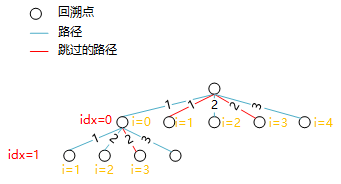给定一个数组 candidates 和一个目标数 target ,找出 candidates 中所有可以使数字和为 target 的组合。
candidates 中的每个数字在每个组合中只能使用一次。
说明:
所有数字(包括目标数)都是正整数。 解集不能包含重复的组合。
示例 1:
输入: candidates = [10,1,2,7,6,1,5], target = 8,
所求解集为:
[
[1, 7],
[1, 2, 5],
[2, 6],
[1, 1, 6]
]示例 2:
输入: candidates = [2,5,2,1,2], target = 5,
所求解集为:
[
[1,2,2],
[5]
]这一题与39. 组合总和相似,最大的不同在于:数组中存在重复元素,但不能重复使用。
第二类:对某种数结构和算法的使用
使用的算法:在给定的元素集合中,找到满足条件的组合,使用“回溯算法“
数据结构:回溯算法需要构建空间状态树,使用树结构
“回溯算法”要确定以下条件,然后构建出解集的空间状态树。
(1)选择列表
给定的数组就是选择列表,与前面相同,为了减少递归层次,先把数组排序。
(2)路径
记录已经选择的元素值,以及当前路径中所有元素和值与 target 的差值。
(3)结束条件
达到什么条件时结束结束当前节点的遍历?
- 路径中所有元素值与 target 的差值小于等于0:
- 小于0,当前路径无效
- 等于0,把路径添加到结果集
(4)选择
什么条件下才把当前元素添加进路径中?
因为每个元素只能使用一次,所以在遍历数组时,要跳过当前元素。
另外,存在重复元素但不允许重复路径,因此在选择元素时,要判断是否与前一个元素相等(数组是有序的),如果相等就跳过,不相等才添加进路径。
这里会引起另一个问题,如下面的“空间状态树”所示,图中
从图中可以看出:
1、当idx = 0 时,i = 1、i = 3的路径是无效的,因为
2、当idx = 1 时,虽然都满足条件 i = 1的路径是有效的,i = 3的路径是无效的
3、也就是说,如果相等的两个元素在同一层的递归中,那么就要跳过第二个元素
怎么判断相等的两个元素是否在同一层递归中?
如果满足条件
-
$idx == 0$ ,这两个元素都在一层递归中,跳过 -
$idx != 0$ ,如果$ i - 1 == idx - 1$,说明这两个元素不在同一层递归中,可以添加进路径中
这部分代码判断如下:
if (i > 0 && candidates[i - 1] == candidates[i]) {
if (idx == 0) {
continue;
} else {
if (i - 1 != idx - 1) {
continue;
}
}
}每层递归开始时,只有第一个元素会和上一层做比较,因此可以通过比较 i 和 idx 的值来简化上面的判断。
最外层条件$ i > 0$,第一个内层条件是:$idx == 0$,导致
if(i != idx && candidates[i - 1] == candidates[i]) {
continue;
}class Solution {
public static void main(String[] args) {
int[] candidates = new int[]{10, 1, 2, 7, 6, 1, 5};
int target = 8;
System.out.println("=======" + new Solution().combinationSum2(candidates, target));
}
public List<List<Integer>> combinationSum2(int[] candidates, int target) {
Arrays.sort(candidates);
List<List<Integer>> res = new ArrayList<>();
List<Integer> path = new ArrayList<>();
backtrack(res, path, candidates, target, 0);
return res;
}
/**
* 回溯递归
*
* @param res 结果集
* @param path 路径
* @param candidates 选择列表
* @param diff 与目标值的差值
* @param idx 当前遍历的元素下标
*/
public void backtrack(List<List<Integer>> res, List<Integer> path, int[] candidates, int diff, int idx) {
if (diff == 0) {
res.add(new ArrayList<>(path));
return;
}
if (diff < 0) {
return;
}
for (int i = idx; i < candidates.length; i++) {
if (diff - candidates[i] < 0) {
// 结束遍历
break;
}
// 选择判断
if(i != idx && candidates[i - 1] == candidates[i]) {
continue;
}
path.add(candidates[i]);
backtrack(res, path, candidates, diff - candidates[i], i + 1);
path.remove(path.size() - 1);
}
}
}1、通过排序来减少递归层次,并跳过重复的元素
2、递归会造成重复的元素在不同层次上,要做特殊判断
